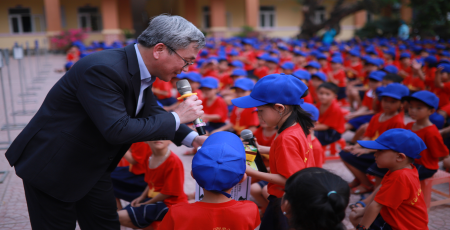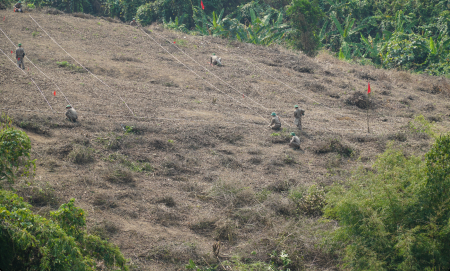At present, Vietnam has over 6.1 million hectares of land (about 18.71% of its total area) polluted by post-war bombs and mines. The work of bomb and mine clearance needs a large budget in a long time and the support from other countries and international organizations. The Vietnam-South Korea Mine Action Project has been implemented and initially brought about the practical effectiveness.
Under the policy by the governments of Vietnam and South Korea on the joint effort to overcome the consequences of post-war bombs and mines in Vietnam, on March 8th 2017, the Vietnamese Prime Minister issued the Decision 303/QĐ-TTg on approving the Vietnam-South Korea Mine Action Project under the sponsorship of the Korea International Cooperation Agency (KOICA). This is the first OAD project by the South Korea Government for Vietnam which is aimed at helping the provinces of Quang Binh and Binh Dinh settle the bomb and mine consequences.
 |
| Sr. Col. Nguyen Hanh Phuc giving presents to students joining the knowledge contest on bomb and mine accident prevention and control |
To execute the Project, on April 3rd 2017, the Ministry of National Defence (MND) issued the Decision 1027/QĐ-BQP on assigning the Vietnam National Mine Action Centre (VNMAC) to be the Project owner. Under the signed agreement, the VNMAC will cooperate with the People’s Committees of Binh Dinh and Quang Binh and the Engineer units in surveying about 8,000 hectares of land contaminated by bombs and mines, providing health support and rehabilitation services for 200 victims and vocational education for 500 victims, building Charity Houses for 50 families of bomb and mine victims in extreme difficulty, and enhancing the capacity to complete the policies for coordination and the services for victims of post-war bombs and mines. At the same time, it will cooperate with other forces in conducting the work of propagation and education to raise the people’s awareness so that they could prevent and avoid bomb and mine accidents. Besides, the Project will support the collection of information about bombs and mines and relevant information as the basis for formulating the policies and improving the capability in settling the bomb and mine consequences.
This is a project of profound humane significance that will greatly help attract the resources of countries and international organizations to Vietnam’s National Mine Action Program (aka the Program 504). At the same time, it will prove Vietnam’s capability in receiving and effectively using foreign financial assistance to contribute to settling the issues on local social welfare and socio-economic development. The Project’s success will help cement the friendly relations between the Vietnamese Government and people and the South Korea Government and people, while laying a solid foundation for other projects with the greater influence on and more benefits for the settlement of post-war bomb and mine consequences in Vietnam. The Project is carried out between 2018 and 2020, including 5 components, namely technical survey and bomb and mine clearance, support for bomb and mine victims, propagation and education to raise the people’s awareness towards the prevention of bomb and mine accidents, support for the system of information about post-war bomb and mine clearance, and support for managing, supervising, and assessing the state of post-war bombs and mines in the above-mentioned provinces. The Project is undertaken by many forces; the Engineer Force is in charge of technical survey and bomb and mine clearance; other forces from the Ministry of Labour, Invalids and Social Affairs and relevant offices of Quang Binh and Binh Dinh provinces are in charge of other tasks. Thus, it is important to coordinate the forces in the Project in a procedural, safe fashion.
The Project commenced in September 2018. After nearly 1 year, in spite of the large area and changes in the participating forces, the VNMAC and engineer units have proactively overcome difficulties, completed technical surveys of thousands of hectares of land, and correctly identified the zones contaminated by bombs and mines for clearing, collecting, and settling tens of thousands of pieces of unexploded ordnance (UXO). In the 4th quarter of 2018 only, the forces surveyed 4,794 hectares of land; in Quang Binh, they indentified 1,245 hectares of contaminated land out of 1,360 hectares of surveyed land and settled 1,129 pieces of UXO; in Binh Dinh, they indentified 1,404 hectares of contaminated land out of 3,435 hectares of surveyed land and settled 639 pieces of UXO. Meanwhile, the forces in charge of propagation and education have executed the programs to enhance the capacity to prevent bomb and mine accidents for 71 cadres of the provinces, districts and schools, completed the survey on awareness, attitude, and behaviour in 11 communes and 8 schools, and provided knowledge for 4,500 locals, including 1,000 women, 903 men, 1,233 female children, and 1,364 male children as the basis for developing the approaches to education related bomb and mine accident prevention and control.
Those initial results of the Project have given us many valuable lessons on leading, directing, coordinating, and operating the Project and laid a solid foundation for the VNMAC to continue fulfilling the remaining targets of the Project. In the process of executing the Project, the VNMAC’s Party Committee and Directorate have drawn some initial experiences as follows.
First, proactively making preparations for initiating the Project (legal foundation, forces, and equipment) and coordinating and managing it. Right after the Decision 1027 by the MND, the VNMAC’s Party Committee developed a special resolution, assigned specific tasks to each Party Committee member, particularly appointed the members of the Directorate to directly direct and coordinate each component of the Project, established sub-committees to formulate the detailed plans for the Project’s components, and assigned the tasks to the affiliates. At the same time, it has advised the MND on establishing the Committee for Coordinating the Project and the Committee for the Project Management. It has established 2 On-Site Command Boards; developed the plans on training courses, especially those related to technical surveys, safety regulations, profile construction, and acceptance procedure for its staff members. The VNMAC has also provided refresher courses for all forces taking part in technical surveys and bomb clearance. Focuses of the courses have been placed on the methods of conducting technical surveys, identifying the zones contaminated by UXO, using GPS devices and technical equipment, and building on-site maps.
 |
| Bomb and mine clearance |
Fully aware of this important task, the VNMAC’s Party Committee has introduced the Project’s contents to its staff members and promoted the core role of its cadres and employees, particularly the cadres who are experienced in other projects. In the process, the VNMAC has closely cooperated with relevant ministries, sectors, and the 2 provinces in organizing consultation and hiring experts on the field of bomb and mine; in frequently exchanging information to deal with the arising issues; in proposing the measures to implement the Project on schedule and effectively. The all-level party committees and commands have introduced the tasks to all cadres and party members in order to raise their awareness and responsibility for the work of bomb and mine clearance and the Project; created a favourable condition for cadres to proactively overcome difficulties, study documents, and go on business trips to grasp the situation and perform their assigned tasks.
Second, closely assigning the Project’s components to the affiliates, conducting technical surveys to correctly indentify the zones contaminated by UXO, effectively and economically use resources for the work of bomb and mine clearance, and enhancing the capability in managing and operating this work. Before conducting technical surveys in any locality, units had conducted non-technical surveys on the basis of documents in the profiles provided by district-level military offices and the bombing maps provided by America, and interviewed witnesses and households living and farming in the Project’s zones and the zones suspected to be contaminated by bombs and mines. Grounded on the non-technical surveys, units have conducted technical surveys of the zones according to localities’ socio-economic development targets while the contaminated zones have been marked and located on the maps and described in a detailed way on the survey note. After the surveys, the zones not contaminated by bombs and mines would be handed over the localities while the contaminated zones would be classified under the regulations and cleared for the sake of long-term farming and economic development.
While conducting technical surveys and bomb clearance work - the main, most onerous component of the Project, VNMAC has cooperated with partners, offices and localities in gradually implementing other components of the Projects.
Third, attaching importance to ensuring safety for the forces and gathering information on UXO. To maintain the absolute safety for the personnel and equipment, it has been a must for the forces to observe the regulations and especially the procedures for the work of survey and bomb clearance. To that end, units taking part in the Project (particularly the Engineer units participating in technical surveys and bomb clearance) must deploy their forces and equipment properly and maintain readiness for performing their tasks in all situations, including the regular and contingency tasks. To ensure the effectiveness, the VNMAC has assigned its cadres to directly direct and inspect the observance of safety regulations in the process, the regulations on military diplomacy, and localities’ regulation as well as the management of civilian-military relationship on site; strictly followed the approved plans and rate of progress; resolutely fought against the disregard for the safety regulations; closely managed the funds, practised thrift, and combated wastefulness.
In addition, the VNMAC has well performed the work of collecting the information, including the information on UXO and bomb and mine victims as well as relevant information as the basis for formulating the policies on handling the bomb and mine consequences. This has also laid a solid foundation for the VNMAC to continue enhancing its capability in counselling, coordinating, managing, and expanding the Program 504 on settling the post-war bomb and mine consequences in Vietnam.
Sr. Col. Nguyen Hanh Phuc, Secretary of the VNMAC’s Party Committee
Deputy Head of the VNMAC